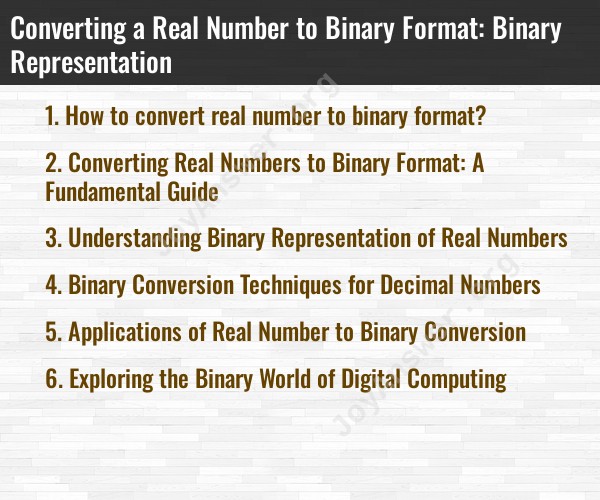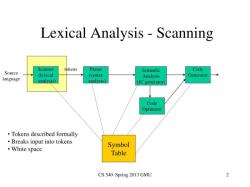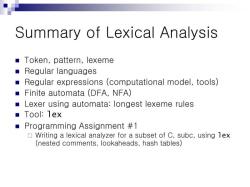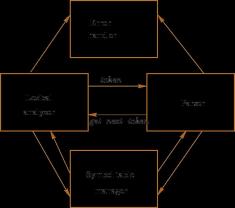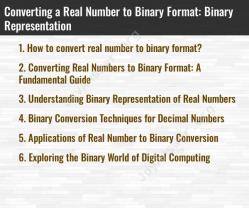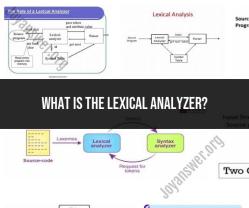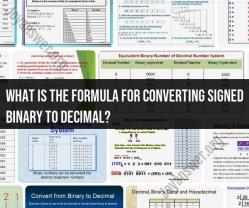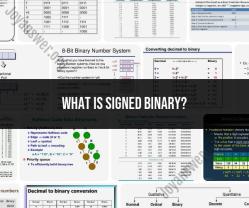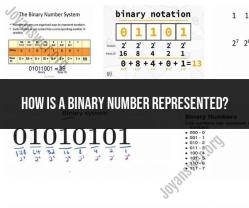How to convert real number to binary format?
Converting a real number (a decimal number with a fractional part) to binary format involves converting both the integer and fractional parts separately. Here's how to do it:
Converting the Integer Part to Binary:
- Start with the integer part of the real number.
- Divide the integer by 2 and keep track of the quotient and remainder.
- Write down the remainder (0 or 1) as the rightmost digit of your binary representation.
- Divide the quotient from the previous step by 2, again keeping track of the new quotient and remainder.
- Write down the remainder as the next digit to the left of the previous one.
- Continue this process, dividing the quotient by 2, writing down remainders, and moving left, until the quotient becomes 0.
For example, let's convert the decimal integer 10 to binary:
- 10 divided by 2 equals 5 with a remainder of 0.
- 5 divided by 2 equals 2 with a remainder of 1.
- 2 divided by 2 equals 1 with a remainder of 0.
- 1 divided by 2 equals 0 with a remainder of 1.
Reading the remainders from bottom to top gives you the binary representation: 1010.
Converting the Fractional Part to Binary:
- Start with the fractional part of the real number.
- Multiply the fractional part by 2.
- The whole number part of the result is the next binary digit.
- Take the fractional part of the result and repeat the process.
- Continue this process until you either obtain the binary representation with the desired precision or until the fractional part becomes 0.
For example, let's convert the decimal fraction 0.625 to binary:
- 0.625 * 2 = 1.25, so the first binary digit is 1.
- 0.25 * 2 = 0.5, so the second binary digit is 0.
- 0.5 * 2 = 1, so the third binary digit is 1.
The binary representation of 0.625 is 0.101.
Combining the Integer and Fractional Parts:After you've converted both the integer and fractional parts to binary, you can simply combine them to get the complete binary representation of the real number.
For example, if you want to convert the real number 10.625 to binary, you'd have 1010 (integer part) and 0.101 (fractional part), which combine to form 1010.101 as the binary representation of 10.625.
Remember that not all real numbers can be represented exactly in binary, and the precision of the binary representation can affect the accuracy of the conversion. Some real numbers may result in infinite binary expansions, and in practice, you may need to round or truncate the binary representation to a certain number of digits or bits.
Converting Real Numbers to Binary Format: A Fundamental Guide
Real numbers are numbers that can represent any value, including fractions and irrational numbers. Binary numbers are numbers that can only represent values of 0 and 1.
Converting real numbers to binary format is a process of representing the real number as a sequence of binary digits. This process can be accomplished using a variety of methods, but the most common methods are the following:
- Floating-point representation: This method represents a real number as a combination of a significand and an exponent. The significand is the mantissa of the real number, and the exponent is the power of 2 by which the significand is multiplied.
- Fixed-point representation: This method represents a real number as a fixed number of binary digits. The number of binary digits used to represent the real number determines the precision of the representation.
Understanding Binary Representation of Real Numbers
The binary representation of a real number is a sequence of binary digits that represents the real number. The sequence of binary digits is typically represented as a fraction, where the numerator is the integer part of the real number and the denominator is the power of 2 by which the integer part is multiplied.
For example, the binary representation of the real number 10.125 is the following:
10.125 = 10 + 1/2 + 1/4 + 1/8 = 1010.0125
Binary Conversion Techniques for Decimal Numbers
There are a number of techniques for converting decimal numbers to binary format. The most common techniques are the following:
- Long division: This method involves repeatedly dividing the decimal number by 2 and recording the remainders. The remainders are read in reverse order to obtain the binary representation of the decimal number.
- Shifting: This method involves repeatedly shifting the decimal number to the right and recording the carry bits. The carry bits are read in reverse order to obtain the binary representation of the decimal number.
Applications of Real Number to Binary Conversion
The conversion of real numbers to binary format is used in a variety of applications, including the following:
- Digital computing: Digital computers use binary numbers to represent all data and instructions.
- Computer graphics: Computer graphics use binary numbers to represent images and videos.
- Networking: Networking protocols use binary numbers to represent data packets.
Exploring the Binary World of Digital Computing
The binary world of digital computing is a fascinating place. Binary numbers are the foundation of all digital computing, and they are used to represent all data and instructions.
The conversion of real numbers to binary format is an essential part of digital computing. By understanding how to convert real numbers to binary format, we can better understand how digital computers work.
Conclusion
The conversion of real numbers to binary format is a fundamental process in digital computing. This process is used in a variety of applications, including digital computing, computer graphics, and networking. By understanding how to convert real numbers to binary format, we can better understand the binary world of digital computing.
